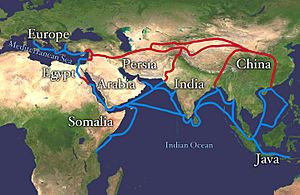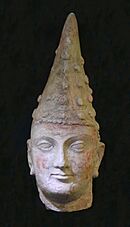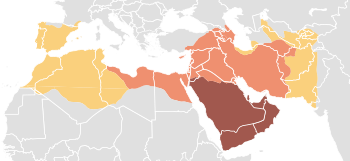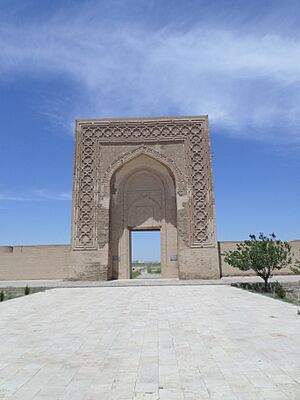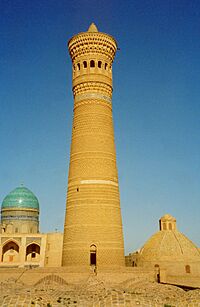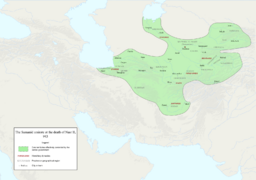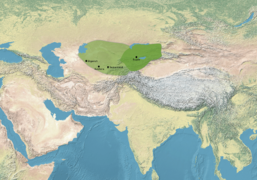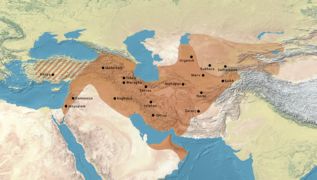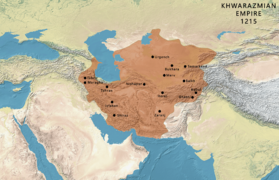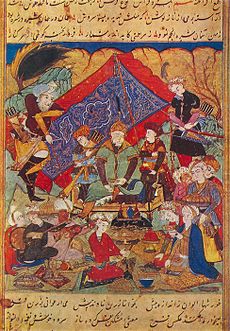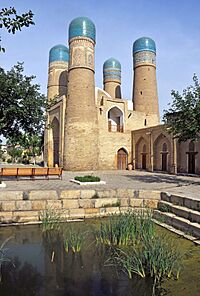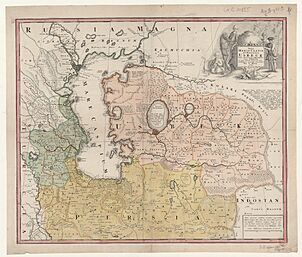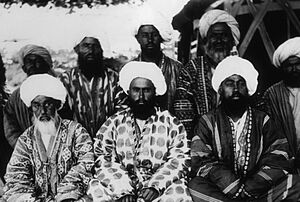History of Uzbekistan facts for kids
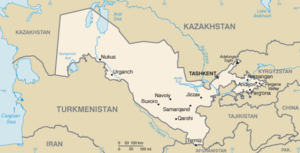
Uzbekistan is a country in Central Asia that is completely surrounded by land. This means it has no coastlines or access to the sea! It's even surrounded by five other landlocked countries: Kazakhstan to the north, Kyrgyzstan to the northeast, Tajikistan to the southeast, Afghanistan to the south, and Turkmenistan to the southwest.
The biggest city and capital of Uzbekistan is Tashkent. Most people in Uzbekistan speak the Uzbek language, which is part of the Turkic languages family. Russian is also widely used for communication between different ethnic groups and in government. The main religion in Uzbekistan is Islam.
Long ago, this area was known as Sogdia and Bactria. It has a very rich history, with many different groups of people living there and powerful empires rising and falling.
Contents
- Ancient Times: Early Settlers and the Silk Road
- Early Religions and Cultures
- Turkic Influence and Early Islamic Period
- Turkic States and Mongol Invasion
- Timur and the Timurid Empire
- The Uzbek Period and Decline of the Silk Road
- Russian Conquest and Rule
- The 20th Century: Revolutions and Soviet Rule
- The 1980s and Independence
- Images for kids
- See also
Ancient Times: Early Settlers and the Silk Road
The first people we know about in Central Asia were the Scythians. They were nomads who came from the northern grasslands around 1000 BC. These nomads settled down and built amazing irrigation systems to bring water from rivers to their farms.
Important cities like Bukhara and Samarkand started to grow. They became centers for government and culture. By 500 BC, the regions of Bactria, Sogdia, and Tokharia were very powerful.
When China began trading silk with the West, cities in this region became important trade hubs. People from Sogdia, who were great merchants, became very rich by helping with this trade. This famous trade route became known as the Silk Road. Because of it, cities like Bukhara, Samarkand, and Khiva became incredibly wealthy.
For a short time, Alexander the Great conquered this area in 328 BC. After him, different empires ruled, including the Seleucid Empire and the Kushan Empire. Later, Turkic peoples arrived and became a major part of the population.
Early Religions and Cultures
Before Islam arrived, the region was ruled by Hindu kings for many centuries. The Kushan Empire was especially important. During this time, both Hinduism and Buddhism thrived, and there was a great flourishing of science, art, and culture.
In these early centuries, Zoroastrianism was the main religion. But Buddhism, Manichaeism, and Christianity also gained many followers.
Buddhism's Journey to Central Asia
Many Buddhist sites are found around Termez in southern Uzbekistan. This is because the Greco-Buddhist culture from Gandhara (in modern Pakistan and Afghanistan) greatly influenced the region. Buddhism traveled along trade routes from Gandhara, reaching Bactria and then Sogdia. Later, it spread to southern Kazakhstan and northern Kyrgyzstan.
Turkic Influence and Early Islamic Period
Around 563–567 AD, the area of modern Uzbekistan became part of the First Turkic Khaganate. The Turks became more influential, and some Turkic rulers even minted their own coins. Some Turks adopted Christianity, Buddhism, or Zoroastrianism, but most kept their traditional beliefs, worshiping deities like Tengri (Sky God).
The Arrival of Islam
In the 8th century AD, Muslim Arabs conquered Central Asia. This brought a new religion, Islam, which is still dominant today. The Arabs were led by a skilled general named Qutaybah ibn Muslim, and they were very motivated to spread their new faith. The local people were easily defeated due to their own divisions.
The new religion spread gradually. The Arab victory over the Chinese armies in 750 AD at the Battle of Talas River firmly established Central Asia as an Islamic region.
Even with Arab rule, Central Asia kept much of its Iranian culture. It remained an important center for culture and trade. The Abbasid Caliphate, which ruled the Arab world for five centuries, was even helped by supporters from Central Asia.
A Golden Age of Learning
During the 8th and 9th centuries, Central Asia experienced a true "golden age." Bukhara became a leading center for learning, culture, and art in the Muslim world. It was as magnificent as other great cities like Baghdad and Cairo.
Many famous historians, scientists, and geographers from this time were from this region. These included al-Bukhari, Al-Tirmidhi, al Khwarizmi, al-Biruni, Avicenna, and Omar Khayyam.
As the Abbasid Caliphate weakened, local Islamic states emerged. The Persian language remained very important for literature and government. Under the Samanids, the rich Perso-Islamic culture continued to flourish.
Turkic States and Mongol Invasion
Starting in the 6th century, more Turkic nomads arrived in Central Asia. These were the Turkic peoples who lived in the vast grasslands from Mongolia to the Caspian Sea. Many of them became soldiers for the Samanid Dynasty.
By the late 10th century, as the Samanids lost control, some of these Turkic soldiers gained power and formed their own states. The first was the Ghaznavid Empire, which conquered large areas of eastern Iran, Central Asia, and Afghanistan.
Then came the Qarakhanids, who took the Samanid capital of Bukhara in 999 AD. Samarkand became the capital of their western state. Later, the Seljuq dynasty also became powerful, but the culture and intellectual life of the region continued to thrive.
In the late 12th century, a Turkic leader from Khorazm united Khorazm, Transoxiana, and Iran. This region continued to be prosperous. However, a new invasion from the north was coming.
The Mongol Conquest
In the early 13th century, Genghis Khan and his Mongol armies invaded. This was a huge turning point in the region's history. The Mongol conquest, from 1219 to 1225, changed the population of Mawarannahr (Transoxiana). Many of Genghis Khan's soldiers were Turkic tribes who joined his army. When these armies settled, they mixed with the local people.
The Mongols caused a lot of damage to cities like Bukhara and the region of Khorazm. Irrigation systems were badly damaged and took generations to repair. Many Iranian-speaking people had to flee south to avoid persecution.
After Genghis Khan died in 1227, his empire was divided among his sons. Most of Mawarannahr remained under the control of Chagatai Khan, Genghis's second son.
-
Extent of the Samanid realm at the death of Nasr II in 943.
Timur and the Timurid Empire
In the early 14th century, the Mongol empire began to break apart. A tribal leader named Timur (also known as Tamerlane) became the most powerful force in Mawarannahr in the 1380s. Even though he wasn't a descendant of Genghis Khan, Timur became the ruler. He conquered all of western Central Asia, Iran, and parts of Asia Minor. He even invaded Russia before he died in 1405 during an invasion of China.

Timur brought many skilled artisans and scholars from the lands he conquered to his capital, Samarkand. He supported them, which led to a rich Perso-Islamic culture in his empire. Many religious buildings and palaces were built in Samarkand and other cities.
Timur's grandson, Ulugh Beg, was one of the world's first great astronomers. During the Timurid dynasty, the Turkic language (specifically the Chaghatai dialect) became an important literary language. The greatest Chaghataid writer, Ali Shir Nava'i, lived in Herat in the 15th century.
After Timur's death, his state quickly split. The constant fighting attracted the attention of the Uzbek nomadic tribes from the north. In 1501, the Uzbeks began a full invasion of Mawarannahr.
The Uzbek Period and Decline of the Silk Road
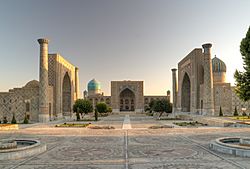
By 1510, the Uzbeks had conquered all of Central Asia, including modern-day Uzbekistan. They established powerful states, with the most important being the Khanate of Bukhara, centered in the city of Bukhara. Another Uzbek state, the Khanate of Khiva, was formed in 1512.
The Uzbeks, who were Sunni Muslims, often fought against Iran, which was led by the Safavid dynasty and was Shia Muslim.
By the end of the 16th century, the Uzbek states started to weaken. This was due to their endless wars against each other and the Persians, and also because of struggles for power among the khans.
Another reason for their decline was the decrease in trade along the Silk Road. New ocean trade routes from Europe to India and China had been established, bypassing Central Asia. As a result, cities like Bukhara and Samarkand began to decline.
The wars with Iran also isolated Central Asia from the rest of the Islamic world. On top of that, nomads from the northern steppes, like the Kazakhs, constantly raided the Uzbek khanates, causing damage and disruption. In the early 18th century, the Khanate of Bukhara lost the fertile Fergana region, and a new Uzbek khanate was formed in Kokand.
In the early 19th century, the three Uzbek khanates—Bukhara, Khiva, and Kokand—had a brief period of recovery. However, in the mid-19th century, Russia became interested in the region's trade potential, especially its cotton.
Russian Conquest and Rule

Russia began its military conquest of Central Asia. By 1876, Russia had taken control of all three khanates, which became part of the Russian Empire. The khanates were given limited self-rule.
During the first few decades of Russian rule, daily life for Central Asians didn't change much. The Russians greatly increased cotton production. Some Russian settlements were built near cities like Tashkent and Samarkand, but Russians generally didn't mix with the local people.
However, Russian rule did bring some social and economic changes. A new middle class grew, and some farmers were affected by the focus on cotton.
Growing Russian Influence
In the late 19th century, new Russian railroads brought more Russians to the area. This led to increased Russian control. The Russians started to interfere more in the internal affairs of the khanates.
A movement called Jadidism emerged among educated Central Asians. They wanted to protect their Islamic culture from Russian influence and modernize their society. By 1900, Jadidism became the first major political resistance movement in the region.
Before 1917, Russian rule brought some industrial development related to cotton. Railroads and cotton-ginning machines improved, but the cotton was sent to Russia for processing. The Russian government greatly expanded cotton farming, which sometimes caused problems with food supply.
The 20th Century: Revolutions and Soviet Rule
By the early 20th century, the Russian Empire fully controlled Central Asia. Uzbekistan's territory was divided into the khanates of Bukhara and Khiva, and the Turkestan Governorate General, which was directly controlled by Russia.
After 1900, the khanates still had some self-rule, but they were under the Russian governor general in Tashkent. Many Russians moved to Central Asia, attracted by the climate and land. Increased contact with Russian culture began to affect Central Asians in larger cities.
Jadidists and Basmachis
Young, educated intellectuals, known as the Jadidists, wanted to learn from Russia and other modern movements to regain their country's independence. They believed their society and religion needed to be reformed.
In 1916, there were violent protests in eastern Uzbekistan against a new Russian rule that forced Central Asians to join the army in World War I.
When the Russian revolutions happened in 1917, the Jadidists saw an opportunity. They tried to set up an independent government in Kokand, but it was quickly crushed. After this, Jadidists and other groups started the Basmachi revolt against Soviet rule. These guerrilla fighters resisted Soviet control for over a decade.
However, many Jadidists, like Fayzulla Khodzhayev, joined the communists. In 1920, Khojayev helped communist forces capture Bukhara and Khiva. He became president of the new Bukharan People's Soviet Republic.
The Basmachi revolt was eventually defeated. Many Central Asians joined the communist party, gaining high positions in the government. In 1924, the Soviet Union created the Uzbek Soviet Socialist Republic (Uzbek SSR), which included present-day Uzbekistan and Tajikistan.
The Stalinist Era
In 1929, Tajikistan and Uzbekistan became separate Soviet republics. As the Uzbek communist party chief, Khojayev enforced Soviet policies, like the collectivization of agriculture. He also tried to increase Uzbek participation in government.
However, Soviet leader Joseph Stalin was suspicious of national leaders. By the late 1930s, Khojayev and other Uzbek leaders were arrested and executed during Stalin's purges.
After this, people loyal to Moscow filled government positions. Economic policy focused on producing cotton for the Soviet Union, ignoring other types of farming. During World War II, many factories from European Russia were moved to Uzbekistan, bringing new Russian and European workers. This made cities like Tashkent more Russian.
Later Soviet Years
After Stalin's death in 1953, some Uzbek nationalists who had been purged were allowed to return. More Uzbeks joined the Communist Party and took government jobs. However, they had to follow Russian rules. Russian was the official language, and adopting Russian ways was often necessary for a government position.
Under Sharaf Rashidov, who led the Communist Party of Uzbekistan from 1959 to 1982, many relatives and friends were brought into government. This led to corruption. Rashidov tried to make Uzbekistan less dependent on Moscow by bribing high officials in the central government. This allowed the Uzbek government to pretend to meet Moscow's high cotton quotas.
The 1980s and Independence
In the mid-1980s, Moscow tried to regain control by removing many Uzbek party leaders. But this only made Uzbek nationalism stronger. People resented Soviet policies like focusing only on cotton and suppressing Islamic traditions.
In the late 1980s, under Soviet leader Mikhail Gorbachev's policies of openness (glasnost), people could express their complaints more freely. Uzbeks spoke out about the cotton scandal, the purges, and environmental problems like the drying up of the Aral Sea.
In 1989, ethnic conflicts broke out in the Fergana Valley. Moscow responded by appointing Islam Karimov as the new Communist Party chief. Karimov was an outsider, meant to ease tensions.
Some intellectuals formed political groups like Birlik (Unity). They pushed for different types of farming, saving the Aral Sea, and making Uzbek the state language.
Uzbekistan Becomes Independent
In August 1991, an attempted coup against Gorbachev in Moscow pushed Soviet republics towards independence. Even though Uzbekistan was hesitant at first, its parliament declared independence on August 31, 1991. In December 1991, a vote for independence passed with 98.2% support. That same month, a parliament was elected, and Karimov became the new nation's first president.
Uzbekistan had to quickly adapt to being an independent country. It needed to build new economic ties and diplomatic relations with other countries. Attracting foreign investment was a challenge, especially with Western countries concerned about human rights.
In 1992, Uzbekistan adopted a new constitution. However, the main opposition party, Birlik, was banned, and media control began. In 1995, a vote extended Karimov's term. Violent incidents in eastern Uzbekistan in the late 1990s led to increased government action against Islamic extremist groups and other opposition.
In 2000, Karimov was reelected in an election that received international criticism. Uzbekistan also started placing mines along the Tajikistan border, causing new regional problems.
In December 2007, Islam Karimov was reelected in an election that international observers said was not fair. Human rights activists reported problems like people voting multiple times. The BBC reported that many people were afraid to vote for anyone other than the president. According to the constitution, Karimov was not allowed to run again, as he had already served two terms.
In 2016, Islam Karimov died. Shavkat Mirziyoyev became Uzbekistan's interim leader and then won the presidential election in December 2016.
On November 6, 2021, President Shavkat Mirziyoyev was sworn in for his second term after winning the presidential election.
In July 2022, protests broke out in the region of Karakalpakstan. People were protesting proposed changes to the constitution that would have ended Karakalpakstan's special status and its right to leave Uzbekistan. The protests were put down harshly, and at least 18 people were killed.
Images for kids
-
Turkish officers during an audience with king Varkhuman of Samarkand 648–651 AD (Afrasiab murals)
See also
 In Spanish: Historia de Uzbekistán para niños
In Spanish: Historia de Uzbekistán para niños
- Bactria
- Samarkand
- Dissolution of the Soviet Union
- History of Asia
- History of Central Asia
- History of the Soviet Union
- List of leaders of Uzbekistan
- Politics of Uzbekistan
- Soviet Central Asia
- Uzbekistan
- Uzbek SSR
- Indo-Aryan migration hypothesis
- Turkic migration


